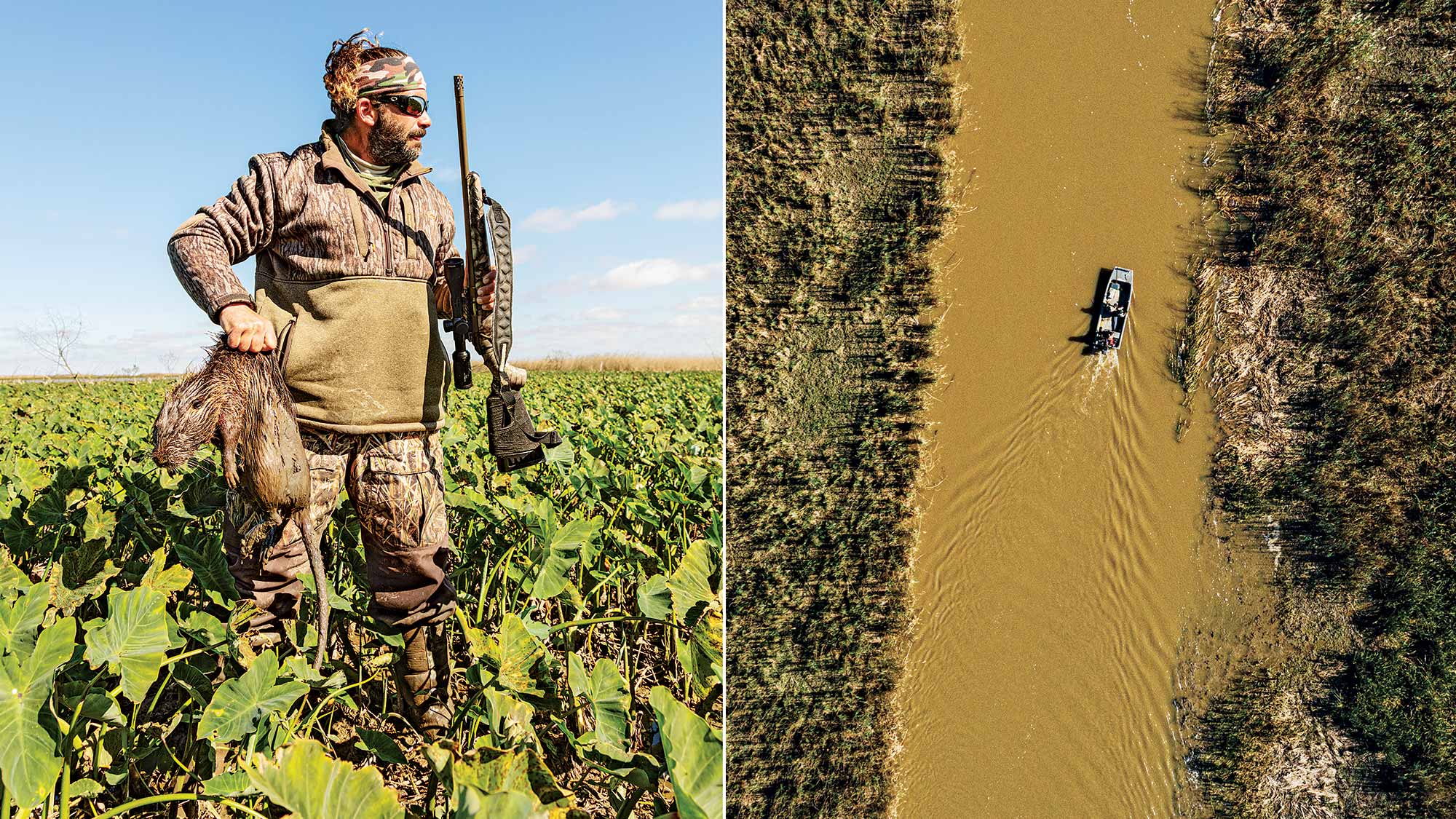I CAN’T HELP but be transported back in time the instant Ryan Lambert hands me a .22 rifle and points his 28-foot mothership hunting barge into the bayous off the Mississippi River. Lambert and I have been close buddies for years, chasing redfish, ducks, and even swordfish together from his lodge out of Buras, Louisiana. But now we’re loaded to the teeth on a cold day in February to hunt…swamp rats. I’m having flashbacks to my childhood.
The phrase “redneck entertainment center” most certainly did not originate at the town dump in Sandisfield, Massachusetts, but that’s where I first heard it. On Saturday summer evenings, my dad, brother, cousins, Uncle Hans, and I spent countless hours there plinking at marauding rats. Dad’s Winchester Model 77 .22 was a thing of beauty to me, and I’ll never forget his stern look when I’d empty its seven shots on a scrambling rat, defying Dad’s single-shot restriction. But he was a softie, and I’d catch him smiling knowingly at my uncle when I burned through another magazine. It was all good. Heck, it was great fun, and he knew it. I had the feeling I was in for this same kind of fun with Lambert.
Motoring alongside us is Walter Heathcock in his 18-foot marsh boat. Standing high in the stern of the skiff, hand on the tiller of his 35 hp Pro-Drive shallow-water outboard, the ponytailed Cajun Rambo looks as grand as George Washington crossing the Delaware in Emanuel Leutze’s iconic painting. There is no Hessian army waiting for us, but there is a different invader lurking across the lower Mississippi River.
At first blush, the conservative Lambert, 62, 30-year owner of the Cajun Fishing Adventures lodge (cajunfishingadventures.com), and the ever-animated Heathcock, 35, owner of Fin Twisters Fishing Guide Services, seem unlikely collaborators for a nutria hunt. You can tell straight off from their choice of primary hunting guns. Lambert totes a wood-stocked Remington 552 .22 LR with a Tasco scope, and Heathcock has a Ruger .17 HMR topped with a Pulsar Trail Thermal slung over his shoulder. Their perspectives also speak volumes.
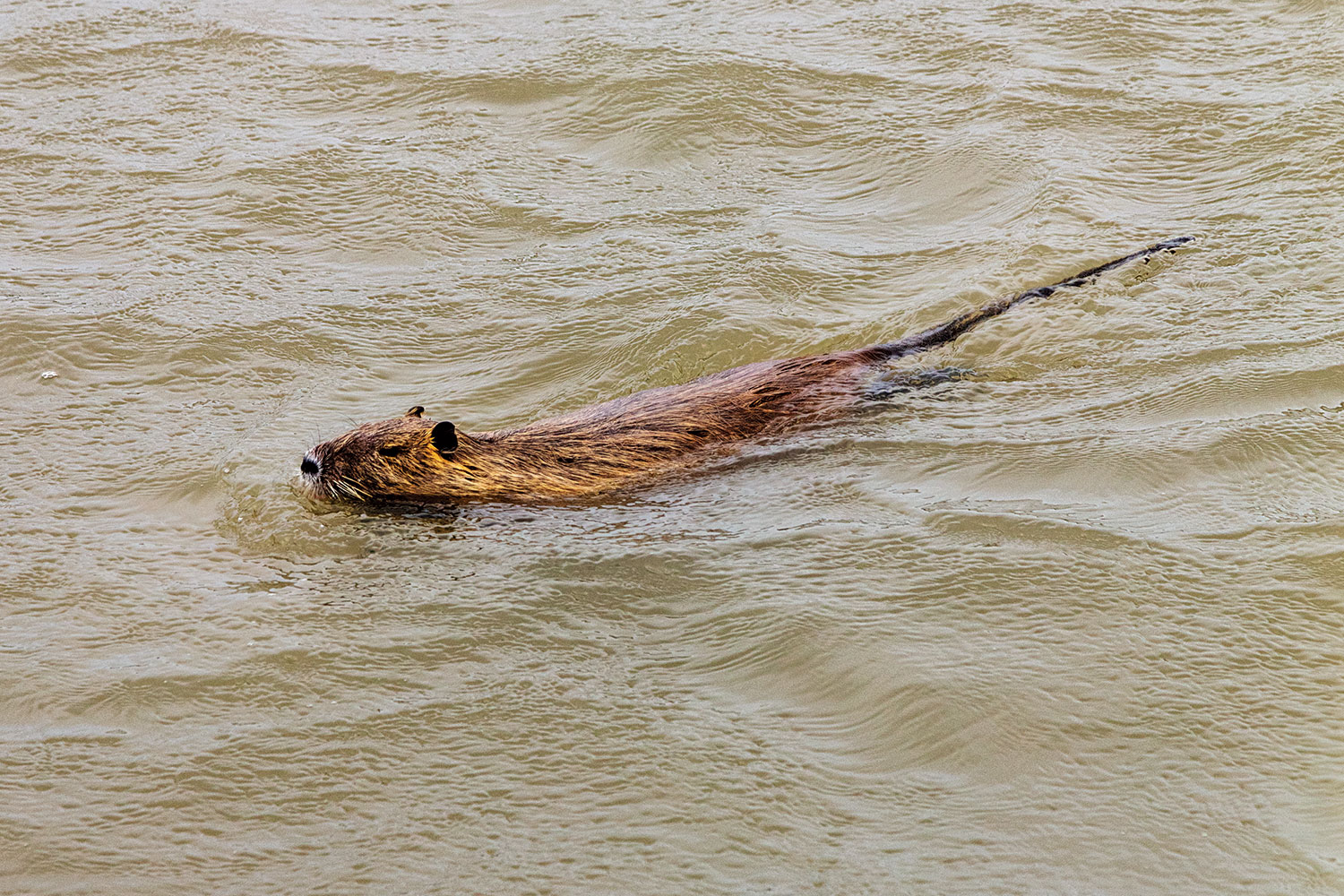
“Honestly, we’re just a couple of Cajun coonasses,” Heathcock says with a wry laugh. “Helping the marsh is an important part of all this, but shooting nutria is also just a lot of fun. I think that once people do it, they’ll understand. I take my 15-year-old daughter all the time, and she loves it. She’s a hell of a shot too. Heck, she shot a running nutria from a moving boat at 50 yards the other day.”
“We’re working hard to restore this marsh and build new land—and we’re doing it well,” says Lambert, who is the heart and soul of the southern Louisiana and Plaquemines Parish coastal restoration effort. “But we’ve got a lot to overcome, and nutria play a part in that equation. They’re everywhere. They feed heavily on plant roots, and burrow and tunnel into levees and dikes. They’re an invasive that destroys a lot of the marsh. And yes, they’re a blast to shoot too—a great way to get kids into hunting. We’ve got lots of wild pigs too, but the nutria are really a bigger problem right now. So, we’re hoping to take folks hunting for them. And yes, we’re just a couple of Cajun coonasses.”

Into the Shooting Gallery
Eventually, we pile into Heathcock’s boat, and as we hit the initial left-hand cut-through off the Mississippi, we spot the first nutria of the day scampering across a marsh flat. Ahead of it is a wild hog, another marsh invasive species, kicking up mud and heading toward the protection of the Roseau cane. Although I had seen dozens of nutria in the past in these very same places while fishing for reds, I’m completely taken aback by the swamp rat’s size. It’s far larger than I remember—and speedier as well. I hadn’t really anticipated spying a hog out in the open during daylight hours either. By the time my brain computes all this and I gauge the lead, I’m able to manage only one wild shot from my Ruger 10/22. Lambert and Heathcock, however, unleash a volley into the marsh. It’s clear this will not be one of those pick-and-poke hunts. By the end of the first marsh encounter, the tally is one dead sow hog—she should have zigged instead of zagged—and no rats.
“Damn things,” says Heathcock to no one in particular. “Stay awake cause there’s lots of them.” And there are.
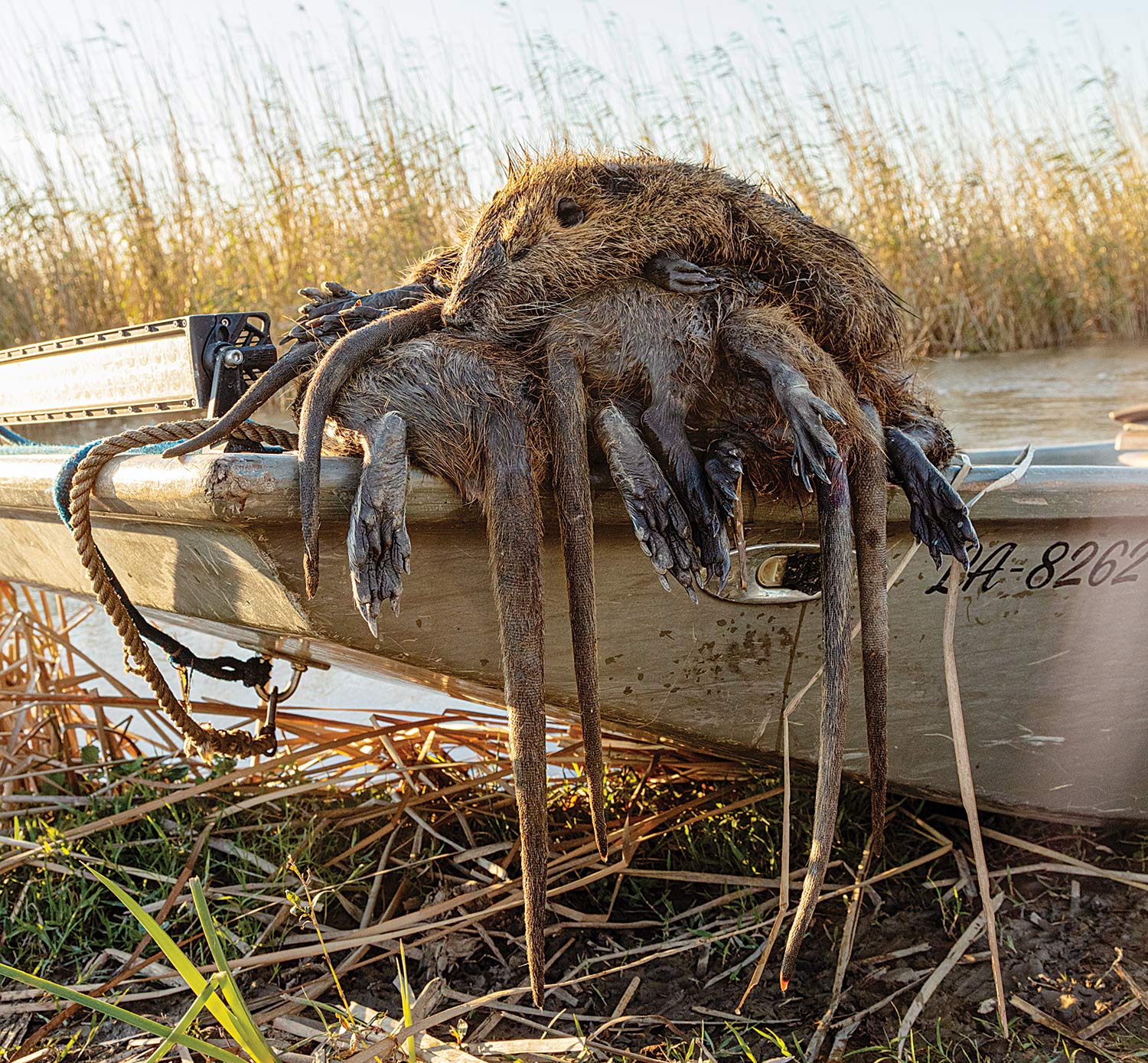
As Lambert and I stay at the ready amidships, Heathcock navigates the mud boat through the miles-long maze of bayous.
“So, outside of spotting the rats themselves, what exactly are we looking for?” I shout to Lambert, trying to be heard above the drone of the motor. “I mean, they’re basically beavers or muskrats with possum tails, but clue me in.”
“I used to trap them all the time when I was a kid,” Lambert says. “I’d look for their mud slides, where they come in and out of the water, and that’s where I’d put my traps. I checked them every day on the way home from school, and I’d sell the hides. We got pretty good money for them back then. So, look for their slides and areas where you can see damage to the vegetation.”
Lambert also tells me that nutria burrow into the marsh banks. You can see their entrances, and the slides usually come from there. The other sign are their nests, which are crude mats of vegetation situated on soil shelves. Nutria often use these as feeding, grooming, loafing, and sunning platforms.
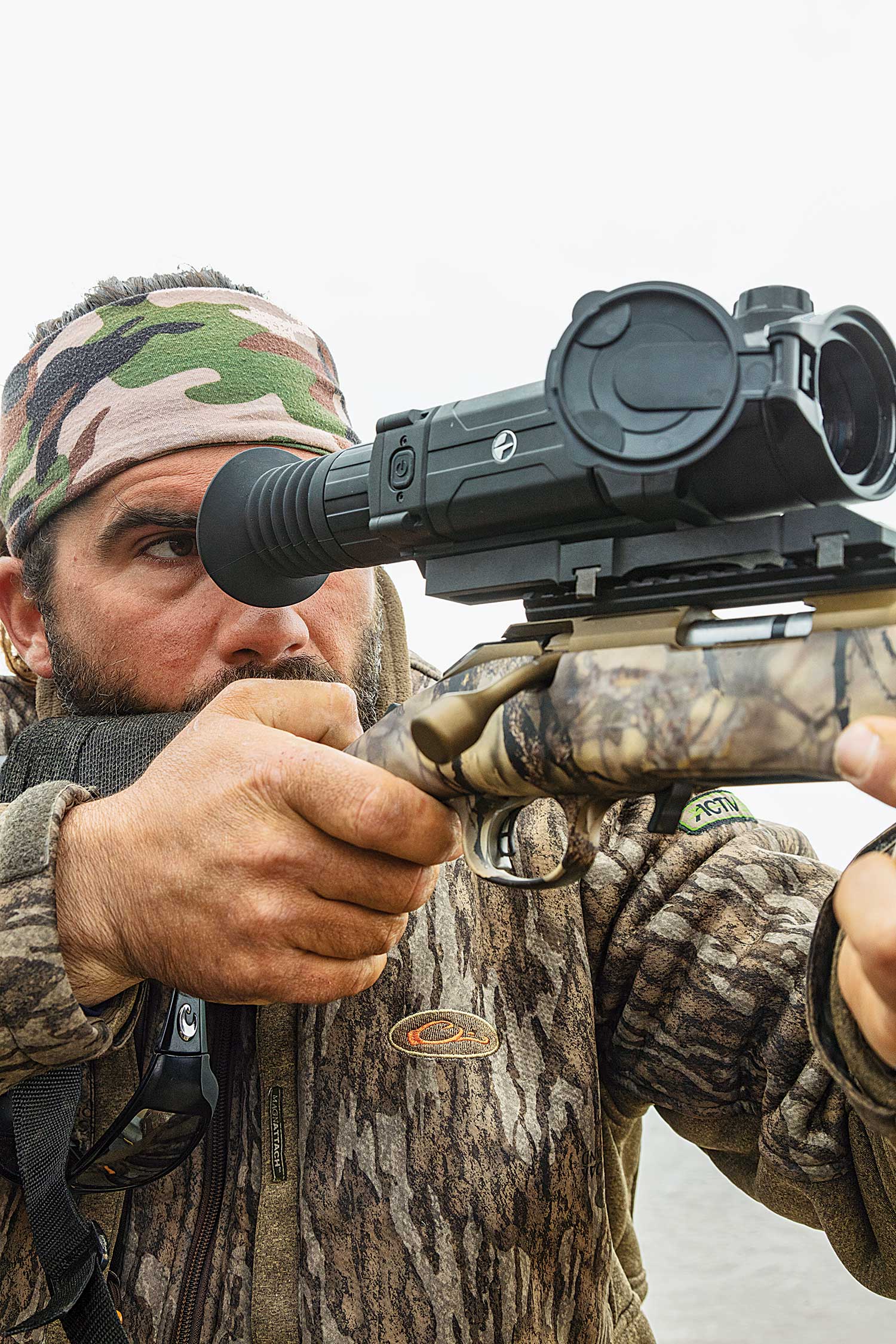
With temperatures in the low 40s, and because nutria activity is impacted by ambient temperatures (a severe freeze in February of 1962 killed millions of nutria in Louisiana), we hope to catch family groups of the rats sunning themselves on these marshy hummocks.
As if on cue, Heathcock shouts at us from his perch on the stern.
“To the left,” he says. “There’s a pile of them.”
Like a swarm of rattlesnakes trying to escape their den, the first rat launches itself off the hummock toward the safety of the Roseau cane, revealing five or six others beneath. The barrage of .22 rounds brings me back to the town dump in Sandisfield, but just for an instant before Heathcock bellows once more.
“Damn, boys,” he says. “Did we really get only one? Wait, there goes one.”
Working quickly, Heathcock fires up the Pro Drive, lurches farther into the bull tongue, and leaps off the bow in hot pursuit of a straggler nutria.
“I’ll get him,” he says. “Come out, come out, little nutria.”
He ends the hide-and-seek with two shots from his .17 HMR, tosses the adult rat on the deck, and jumps back onto the stern.
“Let’s go, boys, there’re more rats to be killed.”
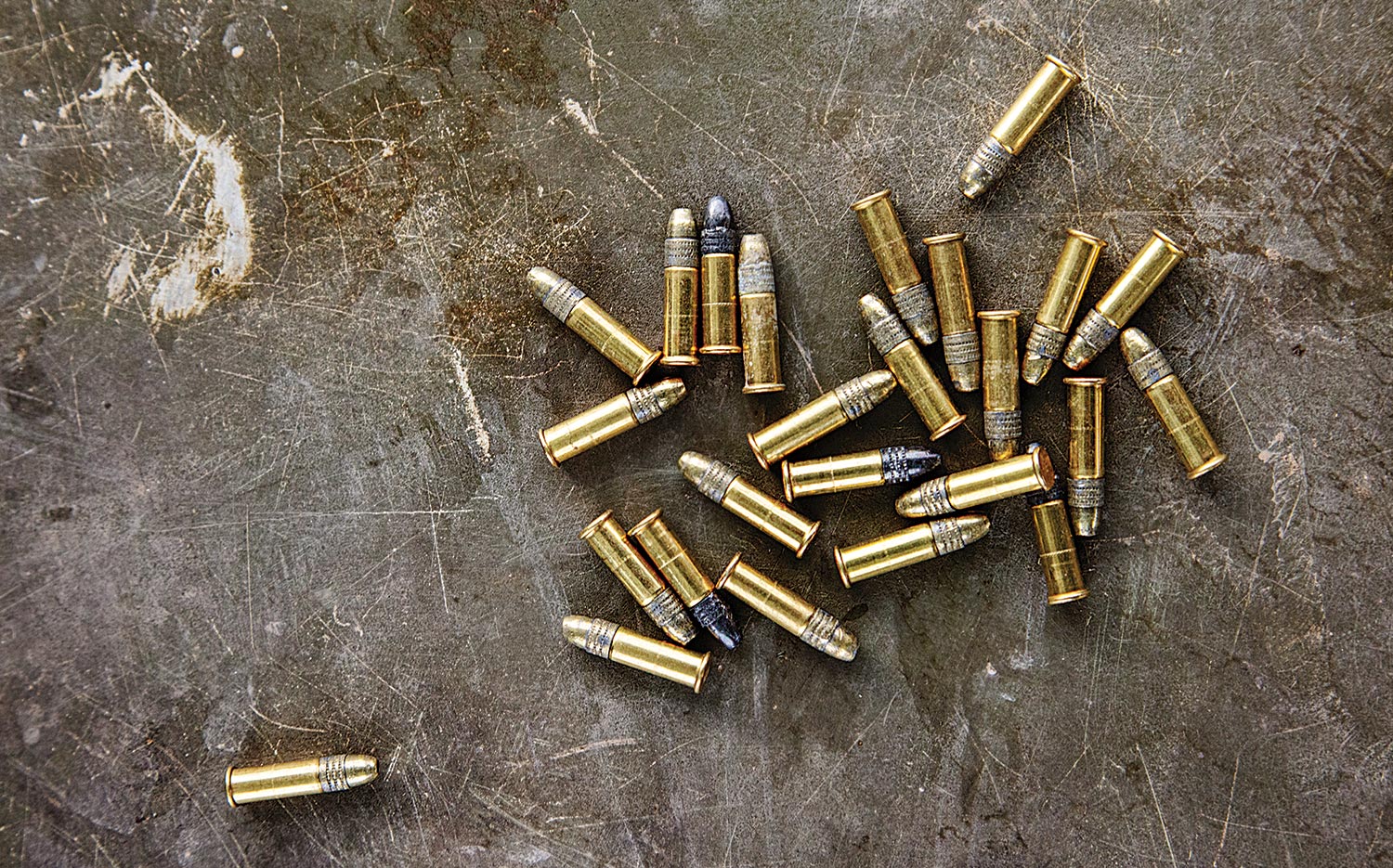
Most nutria weigh 12 to 14 pounds, and they succumb quickly to well-placed head shots with .22s or .17 HMRs. Plenty of hunters opt for a 12-gauge loaded with No. 4s, since most shots are inside 50 yards. Thermal and night-vision scopes are legal for hunting nutria at night, when the rats are most active. (But check local regs before hunting because even though the rats are invasive, there are season dates, restrictions, and bag limits.)
Over the next few hours, we pick off single swimmers, doubles on cane edges, and mudflat runners. We shoot a bunch, laugh a lot, and miss embarrassingly easy opportunities. But we still manage nearly a three-man limit of 15 as the sun begins to set.
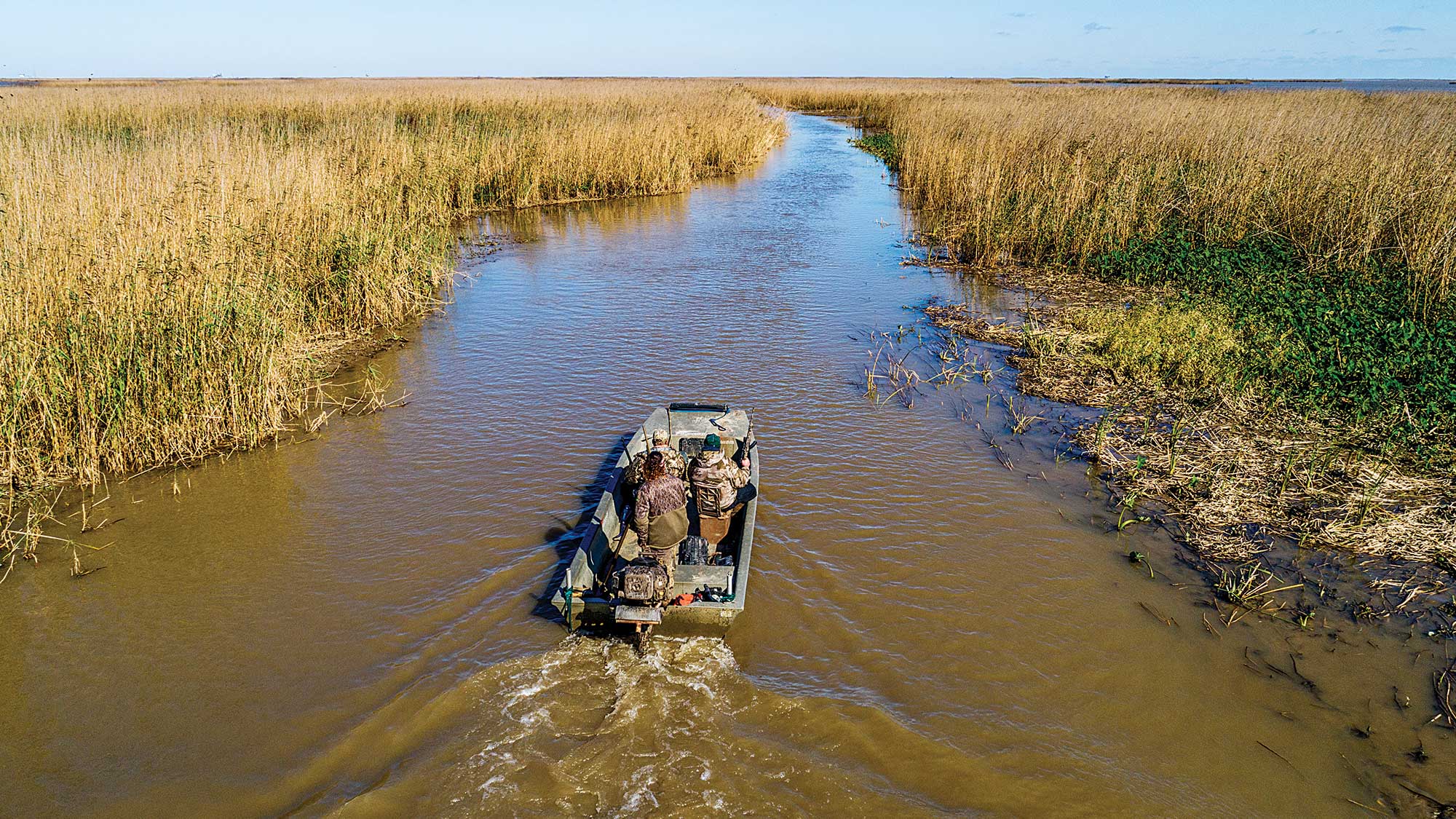
Ohhhhhh Rats!
Nutria may be a blast to hunt, but they are a problematic invasive species—some say a plague—in southern Louisiana, with something of a mysterious history, says Jennifer Hogue-Manuel, Louisiana furbearer biologist and manager of the Coastwide Nutria Control Program (CNCP).
“What we know is that they originated from South America,” Manuel says. “They were likely brought to the United States in the 1930s at the height of the fur industry as a business enterprise. But when it didn’t work out, they were either released or escaped.”
Legend has it that E.A. McIlhenny of Tabasco Sauce fame might have played a role in the intentional release of nutria in an effort to help bolster the local fur industry. In the ’50s, nutria surpassed muskrat both in number of animals trapped and pelt value. Nutria harvest peaked in 1976 at 1.8 million pelts worth $15.7 million. With the ability to breed year-round and rear two litters of one to 13 young a year, the now-wild population of the beaverlike rodents grew rapidly, peaking at about 20 million. By the 1980s, though, a depressed global fur-trade market had weakened harvest incentive, and the population soared. There are invasive nutria in more than a dozen U.S. states, mostly in the Southeast, but there are reproducing populations in Oregon and Washington too. Today, Manuel doesn’t even want to estimate the nutria population in Louisiana.
“With more than 3 million acres of coastal marsh habitat, it’s really impossible to guess,” she says. “Eradication would be nice, but it’s really not possible—there’s no way that it can be done. The damage that nutria cause is vast, and you can see large nutria ‘eat-outs’—where they’ve been feeding on tubers and roots—throughout the marsh. Habitat is lost, and it’s worse than what pigs cause.”
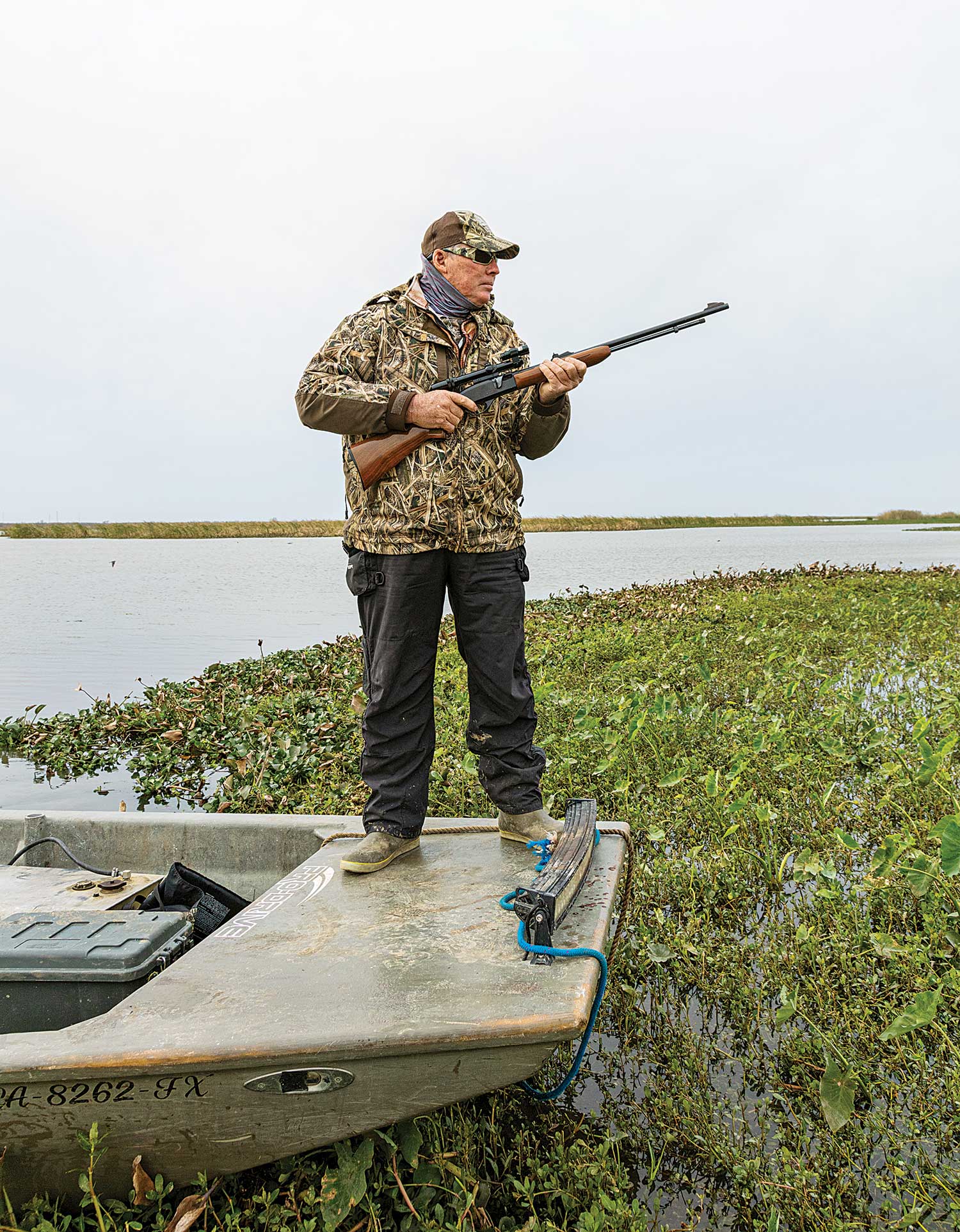
In essence, overgrazing by nutria removes vegetation from the surface of the marsh, which results in the exposure of fragile soil beneath. Erosion through tidal action follows. If damaged soil does not regenerate, tidal scour creates open water. Nutria grazing damages the roots of plants, which makes recovery very slow. A single swamp rat can eat 25 percent of its body weight in vegetation each day and grow up to 20 pounds. “The best that we can hope for is to control them somewhat,” Manuel says.
Louisiana has tried—ambitiously. The CNCP, established in 2002, was designed to remove up to 400,000 nutria each year from coastal marshes. To accomplish that, the CNCP pays a $6 bounty on each -nutria tail turned in by registered participants. Coastal Environments Inc. maintains the program, collects tails at seven designated sites, and distributes the incentive payments. Bounty hunting requires a trapping license, completion of the CNCP application, and registration of the properties to be hunted or trapped. The registered properties must be within a boundary area in southern Louisiana. Incredibly, more than 5 million nutria tails have been collected and more than $25 million paid out since the program’s inception. The most recent data indicates that the CNCP is at least somewhat effective in suppressing nutria damage.

Manuel says nutria-damage estimates were at more than 102,000 acres when the program began. Since the introduction of the CNCP, the number of impacted acres once dropped as low as 4,181. Reduced harvests since the 2015–2016 season, however, resulted in an increase in damaged areas to more than 16,000 acres in 2018.
The Nutria Herbivory Survey, completed in May 2019, documented 14,652 acres of coastal marsh damage caused by nutria—an 11 percent decrease in acreage since 2018. However, the number of damaged sites increased, from 21 to 25, and about 900 acres were converted to open water—essentially destroyed.
River Rats
We had hoped for warmer weather during the day, but the final turn for home came into the teeth of a ceaseless north wind. We all looked forward to a dinner of boudin balls and fresh shrimp, but we weren’t quite done.
“Dude,” Lambert says. “Look on top of that brush on the right. There’s a nutria sitting up there.”
At Lambert’s shot, a big adult nutria plops into the water, and Heathcock follows up, sending the last rat of the day rolling off a marsh mound.
I’m content to watch the action unfold, having already gotten to relive the rat-sniping days of my youth. Heathcock and Lambert will be back at it until the final days of the season, patrolling for rats, collecting bounties, and doing their part to help the marsh.
The Rat Resource

Nutria are a tremendous and abundant renewable resource, whether to be worn or eaten.
Although it might take a bit to persuade food snobs to try it, wild nutria meat, or ragondin, is higher in protein and lower in fat and cholesterol than beef, chicken, or turkey, and tastes remarkably like cottontail.
Lambert’s preparation is simple. He dredges the deboned meat in creole seasoning and browns it in vegetable oil. Next, he removes the meat, adds a mirepoix of carrots, onions, and celery, and returns the meat to the stew pot with a cup or so of wine. He finishes it all off with a roux once the meat begins to fall apart.
This story originally ran in the Spring 2020 issue. Read more OL+ stories.
